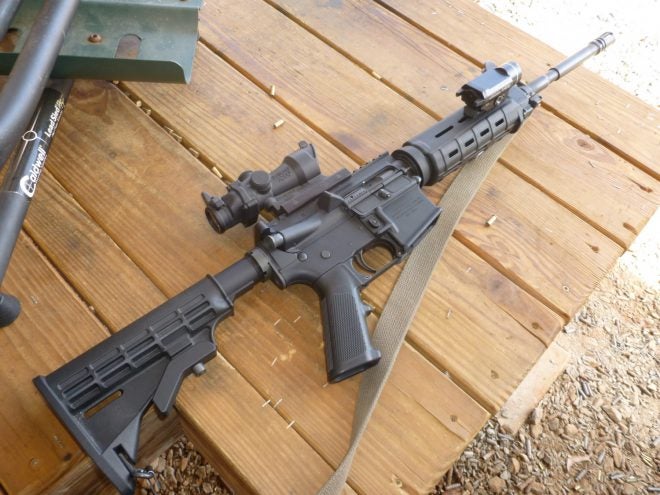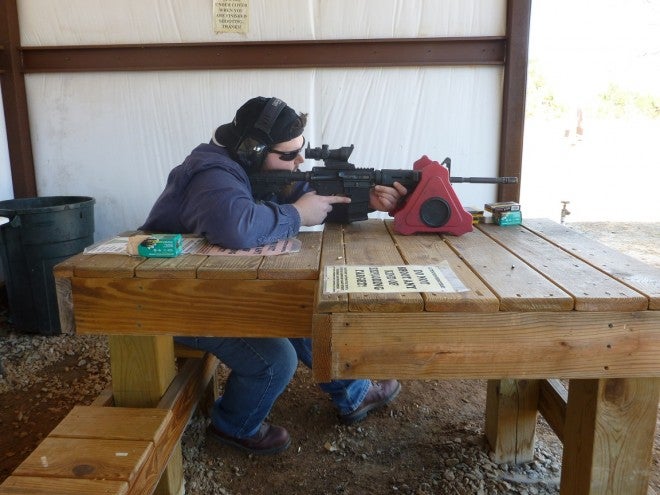Four years ago, frustrated after having a bad experience with an Armalite AR-180B, I purchased a Colt 6920 rifle from a gun store in Northwest Louisiana, which I was passing through at the time. Since then, I have put close to five thousand rounds of steel-cased ammunition through the rifle, along with about a thousand rounds of brass-cased ammunition. During the past four years, I have tried numerous times to get the rifle to stop working, and only succeeded once. Along the way, I used the rifle to shoot at targets that conventional wisdom says are too far away to hit with a 5.56mm carbine. This review will cover my experiences with the rifle in greater depth, and conclude with why I think the Colt 6920 is a benchmark for civilian self-loading carbines.
Despite my best efforts to push the rifle beyond its limits, I found the Colt to be as reliable as the Yugoslavian M70B1 AK that I owned at the same time. Shooting through Southeast Texas rain and mud, New Mexico sandstorms, and thousands of rounds without cleaning, the rifle proved itself to me as an outstandingly reliable machine. In one of my attempts to make the rifle fail, I picked the most pitiful looking USGI magazine out of about twenty that a friend had brought back with him from his deployment in Iraq. This magazine had broken most of its welds along its spine, and had been crudely re-welded. The sides of the magazine were not quite parallel; the “box” cross-section of the magazine being more of a trapezoid than a rectangle. Despite this, the rifle – which at this point had not been cleaned in over a thousand rounds – worked flawlessly, for over 120 rounds fed from that same magazine. Even so, the only malfunction I ever experienced with the Colt happened while shooting over three hundred rounds through a New Mexico sandstorm. Towards the end of shooting, the bolt failed to lock back on an empty 20-round Pmag. A quick spray of oil through the ejection port with the bolt closed fixed the problem, and I experienced no further issues with the functioning of the rifle.
Throughout the time that I have used the rifle, I have greased the bolt carrier with TW-25b aviation grease. In the summer of 2010, I bought one tube; which is still almost full, as the rifle needs lubrication very infrequently in my experience (I’d say once every thousand rounds or so, depending on the conditions). While probably a more high-end product than the average user will ever need – I have seen AR-15s run perfectly through several hundred rounds in a session, lubricated with old motor oil – this product is relatively inexpensive for how long it lasts when used in moderation. A simple run over the contact surfaces with a lathered cotton swab is enough in my experience to keep the gun running for well over a thousand rounds.
My only major mechanical concern with the rifle involved the barrel nut tension. As part of a gunsmithing course, I once had to completely strip the rifle down to its pins, and to do this I had to remove the barrel. However, the torque on the barrel nut was so great that myself and my instructor were only able to remove it using a cheater bar, a technique that destroyed the teeth on the nut itself. Once the replacement delta ring assembly came in, I torqued it down to about 50 pound-feet. This issue was mostly likely unique to my rifle, and certainly didn’t affect it in any way outside of being able to take it apart easily.
Over the past four years, I’ve stretched the legs of the rifle numerous times, almost always firing Brown Bear 62gr HP ammunition, of which I bought a 5,000 round lot soon after I purchased the 6920. This ammunition, which typically produced 2.5-3” groups at 100 yards, was capable of consistently hitting a man-sized target out to about 900 yards. Beyond that point, the accuracy of the ammunition was not sufficient to guarantee a hit even given the proper dope and elevation. With more accurate ammunition, such as the Hornady 75gr TAP FPD which I found to provide close to MOA performance from the 6920, it may have been possible to extend the range of the rifle even further, though I never tested this.
Though I have fired the rifle with the original iron sights several times, most of my shooting has been done using a TA01NSN ACOG, which I bought used in good condition. I have virtually nothing negative to say about this sight. The reticle is clear, easy-to-read, and uncluttered. The elevation ticks are handy not only for holdover, but also as point-of-impact adjustment. More than once, I’ve sighted the rifle in for my home defense load, and then handed it over to a newer shooter to shoot Brown Bear (which shoots a different POI) and told them “use the second tick, you’ll be dead on”. This saves a lot of time and heartache at the range, besides being extremely handy in the field. Because it is a both-eyes-open scope, the ACOG is well-suited to both close range and long range shooting. The housing is extremely durable, and I do not feel at all as though I need back up irons on my rifle. In short, despite its high price tag, I cannot help but recommend the Trijicon TA01NSN ACOG as an all-around carbine optic.
As a final part of this review, I took to the range to illustrate the accuracy of a rifle with close to six thousand rounds down the tube. All shots were taken at 100 yards, on the bench, using a Hornady rest.
With my old standby, Brown Bear 62gr HP, it still produced groups of about 3” in size.
PMC 62 gr X-TAC LAP produced slightly smaller groups (the topmost shot is most likely the result of shooter error).
And, finally, with my home defense ammunition, T556TNB1 Mk. 318, it produces excellent groups close to 1.5” in size.
Before taking to the range for this review, it had been some time since I’d gotten out to do some benched target shooting. Between concerns that the steel-jacketed Brown Bear ammunition had worn down the barrel’s throat, and not having really put my skills to the test in about a year, I was somewhat worried that the rifle would fail to perform as well as it had in the past. I was pleasantly surprised, not only by the still very-good accuracy of a rifle barrel well into four digits, but also by the excellent accuracy of the T556TNB1 Mk. 318 ammunition.
My Colt 6920 still runs without issue, and shoots great, even after six thousand rounds of mostly steel-cased ammunition. Whatever doubts I once had about the rifle’s design, or Colt’s ability to make a great product are well and truly gone. That the 6920 is industry standard for civilian market self-loading carbines is no mystery to me.
We are committed to finding, researching, and recommending the best products. We earn commissions from purchases you make using the retail links in our product reviews. Learn more about how this works.
 Your Privacy Choices
Your Privacy Choices






